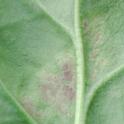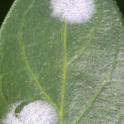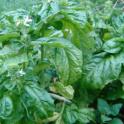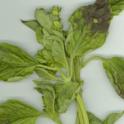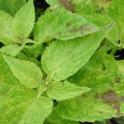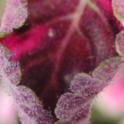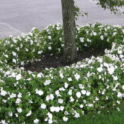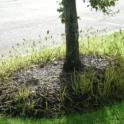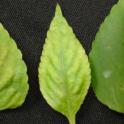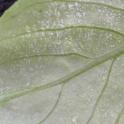Management of Downy and Powdery Mildews: Three New Diseases Hit California
by Deborah M. Mathews
Introduction and Overview
Although the names sound similar and they both produce fuzzy growth on leaves, the pathogens that cause the diseases known as downy mildew and powdery mildew are quite distinct. Powdery mildews have a long history in California and are easily one of the top diseases growers have to deal with. Rose, verbena and crepe myrtle all are common hosts. Downy mildews are equally common; however, over the last few years three devastating diseases caused by downy mildew pathogens have been found in the United States and have recently made their way to California. Impatiens, coleus and basil are all being affected by different organisms but the result is the same: loss of the crop.
Downy mildews are not fungi; they are in a different taxonomic group or kingdom which contains the water molds, the same group that Phytophthora and Pythium species are in. The downy mildews produce lavender, brownish, gray or white spores on the lower surfaces of leaves (fig. 1). Angular yellow spots develop on the upper surfaces, which may become brown and result in defoliation and plant death in severe infections. These pathogens prefer cooler temperatures (45 to 70°F) and humidity above 85%; spore production and infection depend on the presence of free water.
In contrast, powdery mildew is caused by several true fungi and their white-to-gray mycelium and spores are primarily found in round spots on the upper surfaces of leaves (fig. 2), but many can also be found on the lower surfaces and other plant parts. Symptoms are unsightly and can cause distortion, but rarely death. Powdery mildews prefer moderate temperatures (68 to 86°F) and relative humidity of 95%, but do not require free water to reproduce.
An accurate diagnosis is critical for successful management of downy and powdery mildew diseases. However, keep in mind that both types of pathogens can occur at the same time on the same host, making diagnosis more difficult. This article will help you in the identification of these diseases and the implementation of a management program to minimize their effect.
New Downy Mildew Diseases
Basil. On basil, downy mildew is caused by Peronospora belbahrii (fig. 3), a quarantined pathogen in California, meaning that all plants must be destroyed when the pathogen is detected. In 2011, P. belbahrii was found by the California Department of Food and Agriculture (CDFA) at several large retail locations in multiple counties and was traced to seed lots, at least some of which were imported from Italy. Since 2009 there have been several detections of this disease in California, primarily in San Diego and the Central Coast regions, due to their permissive climates.
In early infections this downy mildew disease can be mistaken for a nutritional deficiency since mild yellowing of the leaves is the first symptom to appear and because the spores are only visible on the lower surfaces of the leaves; it can go unnoticed until it has already become established and it is too late for control. In addition to being seed-borne, the spores can be dispersed in the air, spreading rapidly in the field and the greenhouse. Chemical controls are somewhat limited for edible varieties, but check labels for permitted uses. Other control strategies are addressed in the management section below.
Coleus. In coleus, a new form of downy mildew has been appearing since 2006 that is difficult to control. It causes the typical sporulation on the undersides of leaves, but brown and black splotches of tissue appear on the upper sides; the leaves curl, defoliating readily (fig 4) and seedlings are stunted. All cultivars tested seem to be susceptible; little natural resistance is available, although disease severity does vary with the cultivar and some are only mildly affected. The pathogen is in the genus Peronospora but experts have not settled on a species designation — it is similar in many ways to P. belbahrii, but different in others.
Scouting and managing this disease is difficult because it has the ability to remain somewhat dormant and invisible to the eye until the environment is just right; however, once conditions are conducive, symptoms can develop virtually overnight. It is recommended that coleus plants are not kept in the greenhouse between crop cycles due to the pathogen’s ability to harbor symptomless infections when the environment isn’t optimum for disease development. This pathogen is not seed-borne, but seedlings are very susceptible to spores coming from other infected plants, so seed-grown plants should be kept separately from mature plants or vegetatively propagated stocks.
Impatiens. Impatiens (Impatiens walleriana) in greenhouses has been known to get downy mildew for years, but has only recently been severely affected in the landscape by Plasmopara obduscens. New Guinea impatiens is not affected by this disease, nor are other common bedding plants. On the east coast and across the United States last fall, major plantings of I. walleriana were destroyed by downy mildew. It was also found last year in the central and southern coastal regions of California.
This disease develops rapidly. Fig. 5 shows a planting of apparently healthy impatiens around a street tree (A), only to be decimated 5 weeks later (B). The pathogen, P. obduscens, is different from the downy mildew pathogens that attack basil and coleus since it not only produces air-borne spores, but also swimming zoospores and oospores, which are long-term survival structures that can overwinter in the soil from infected leaf and flower debris. The production of oospores means that plant material should not be composted to avoid carryover of the disease.
For impatiens grown in greenhouses, care should be taken to remove any landscape plantings of impatiens on the property so that if they become infected, spores will not migrate into the greenhouse facility. The disease is not seed-borne, but seedlings are quite susceptible to spores from other locations, especially the cotyledons. The first signs of disease are yellowing of a small number of leaves and stunting, followed by white sporulation on the undersides of leaves, and leaf and flower drop (fig. 6). Early detection is especially critical for this disease since once sporulation starts, chemical control has been shown to be ineffective.
Management and Control
You can see that although these diseases may seem similar in name and appearance at first glance, they each have unique differences that make their identification and management separate endeavors. However, both powdery and downy mildews have similar cultural and sanitation strategies to prevent their introduction and reduce their reproduction and spread:
- Use good quality plant and seed material with a history of low disease incidence, selecting varieties with genetic resistance to each disease. Inspect new arrivals and reject or quarantine if in doubt.
- Scout routinely (at least weekly) to identify and remove diseased plants before epidemics can result. For downy mildew, turn leaves over to check for sporulation on the undersides of leaves.
- Reduce humidity by increasing plant spacing and air flow; avoid overhead watering, but if used, apply early in the day to allow for drying of leaves by the afternoon.
- Do not hold plants between crop cycles; remove plant debris and clean benches before new plants are brought in.
Powdery and downy mildews also have similar responses to biological agents used as protectants such as Bacillus subtilis (e.g., Seranade, Cease) and Trichoderma (e.g., PlantShield). Chemical control measures for these two diseases, however, are quite different and must be considered separately. All of these pathogens are very prone to the development of resistance to most chemicals so proper rotation of the modes of action is critical to maintaining effective control. Chemical applications should be considered preventative since once these diseases get started, curative action can rarely be achieved. As with all chemicals, check the label for use on specific crops and locations.
Chemicals for powdery mildew. Contact fungicides work well as preventatives and for early, mild infections, notably potassium bicarbonate compounds and horticultural and neem oils. Phytotoxicity can be a problem with some plants, however, so care should be used before broad scale application. Systemic fungicides include triflumizole (e.g., Terraguard), myclobutanil (e.g., Eagle), the strobilurin group (e.g., Compass O, Insignia, Heritage), which is very prone to inducing resistance in pathogens, and thiophanates (e.g., Cleary’s 3336, OHP 6672).
Chemicals for downy mildew. Contact protectants such as mancozeb (e.g., Protect) and copper, alternated or mixed with systemics like mefenoxam (e.g., Subdue MAXX) applied as a drench at the beginning of the season and sprays of dimethomorph (e.g., Stature DM), phosphonates (Aliette), and strobilurins (e.g., Fenstop, Compass O, Insignia, Heritage), have shown good control. Effectiveness of any given chemical depends on the particular downy mildew pathogen present; what works well for one may give minimal control for others. Tank mixes of more than one of these agents in a rotation can be useful.
References and Further Reading
Basil downy mildew
Wyenandt CA, Simon JE, McGrath MT, and Ward DL. 2010. Susceptibility of basil cultivars and breeding lines to downy mildew (Peronospora belbahrii). HortScience 45(9): 1416-1419.
http://vegetablemdonline.ppath.cornell.edu/NewsArticles/BasilDowny.html
Impatiens downy mildew
http://www.e-gro.org/pdf/Bulletin_1-8_Impatiens_Downy_Mildew.pdf
http://go.ncsu.edu/impatiens_downy_mildew_webinar (a 60-minute webinar by Dr. Colleen Warfield of Ball Hort; log in at website as a “guest” to play video).
Coleus downy mildew
http://www.gpnmag.com/downy-mildew-coleus
Deborah Mathews is UC Cooperative Extension Specialist/Plant Pathologist for Ornamental Crops, Department of Plant Pathology and Microbiology, UC Riverside.
Figures
Click on thumbnail to view entire figure
Fig. 1. Lavender sporulation of downy mildew (Peronospora spp.) on lower surface of leaf. Photo by Dennis H. Hall, courtesy of UC Statewide IPM Program
Fig. 2. Powdery mildew on upper surface of periwinkle leaf. Photo by Deborah Mathews.
Fig. 3. Downy mildew on field-grown basil (A) and dark lesions on upper surfaces of greenhouse-grown plant (B) caused by Peronospora belbahrii. Photos by Margery Daughtrey, Cornell University (A) and Cheryl Blomquist, CDFA (B)
Fig. 4. Downy mildew of coleus causing dark spots on the upper surface of leaves (A) and curling with sporulation on the undersides of the leaf (B). Photos by Margery Daughtrey, Cornell University
Fig. 5. Devastation of impatiens in a landscape planting as downy mildew was first detected (A) and after 5 weeks (B). Photos by Margery Daughtrey, Cornell University.
Fig. 6. Early symptoms of impatiens downy mildew. A) stunting, yellowing of leaves; healthy leaf on right and B) sporulation on underside of impatiens leaf. Photos by Margery Daughtrey, Cornell University.








